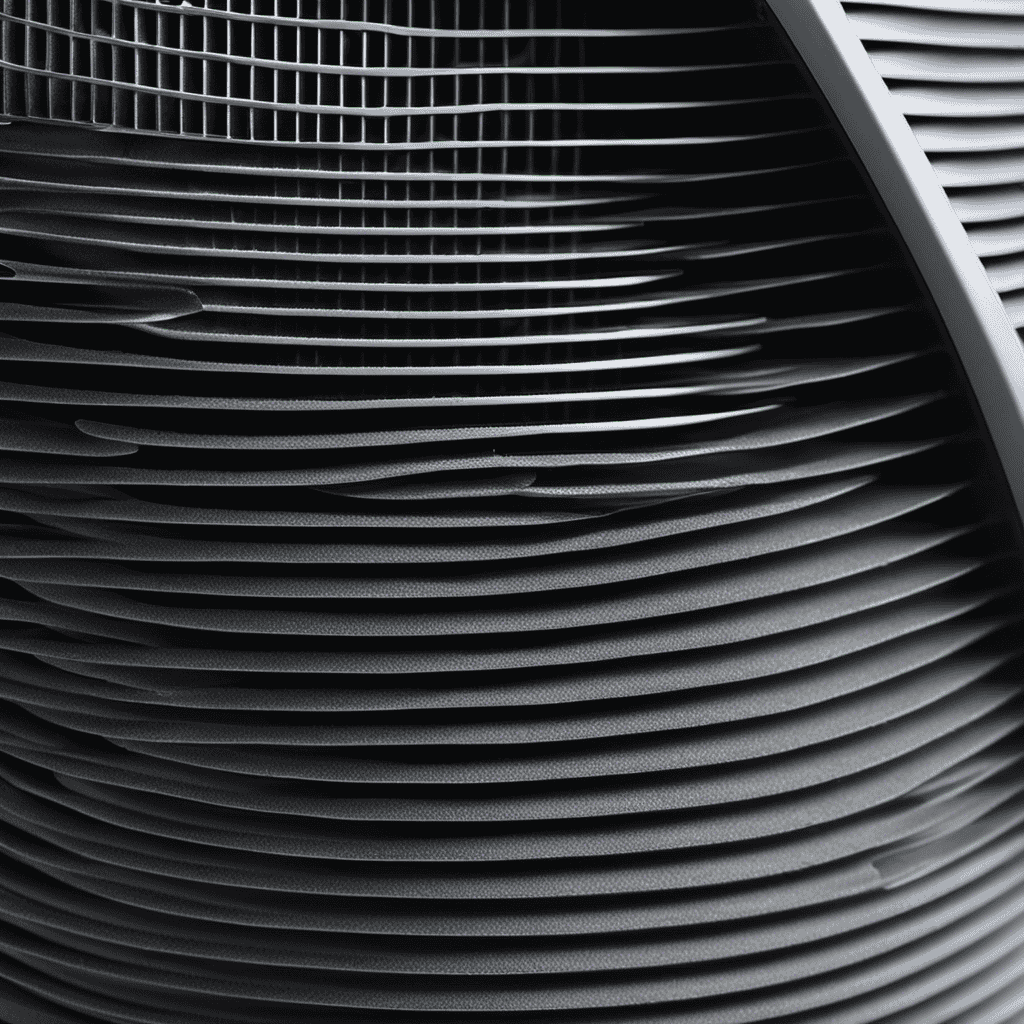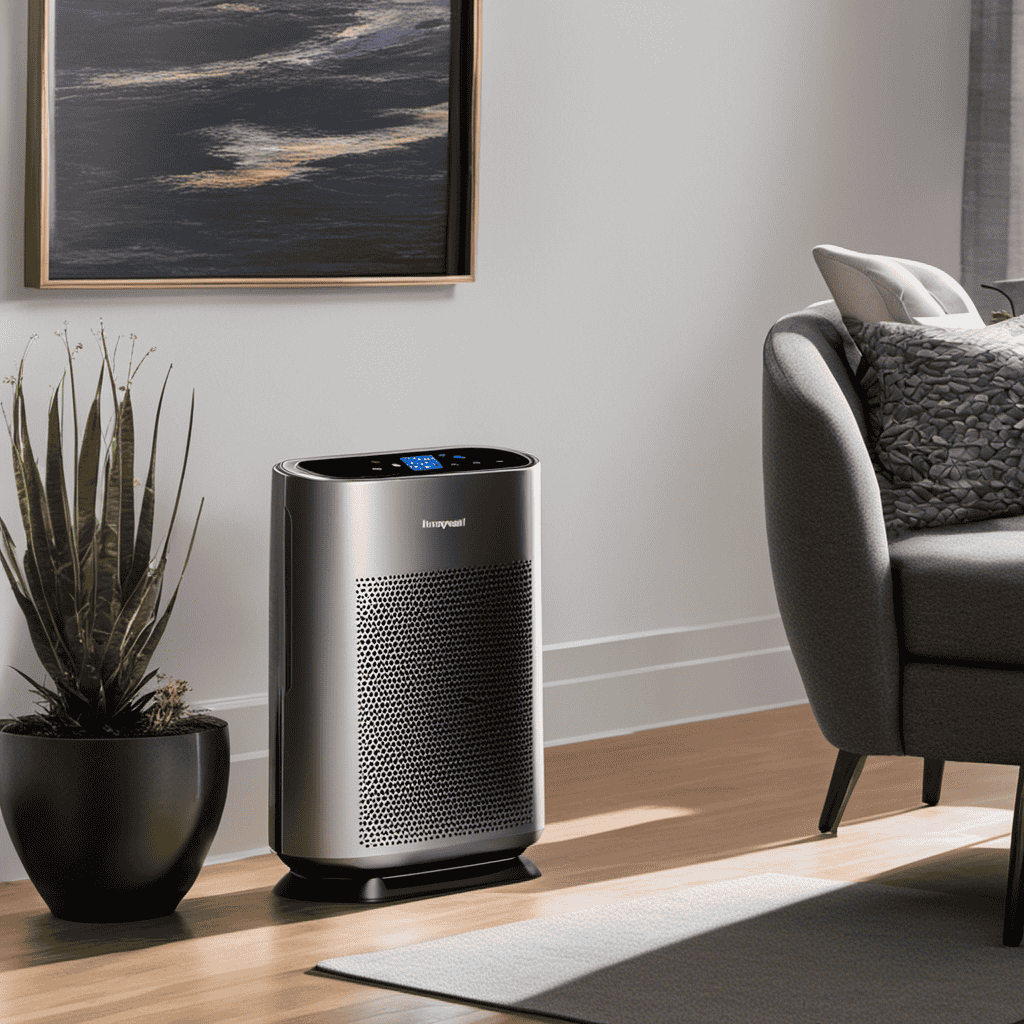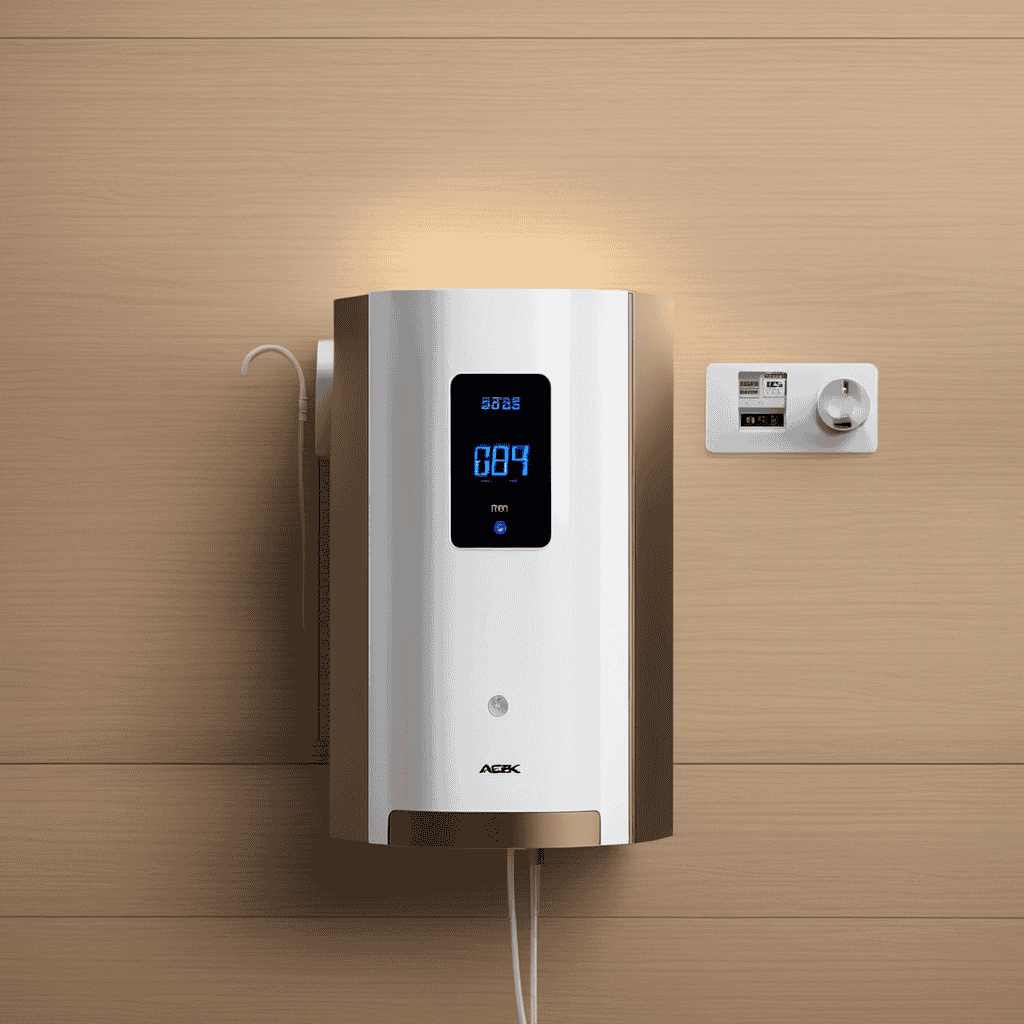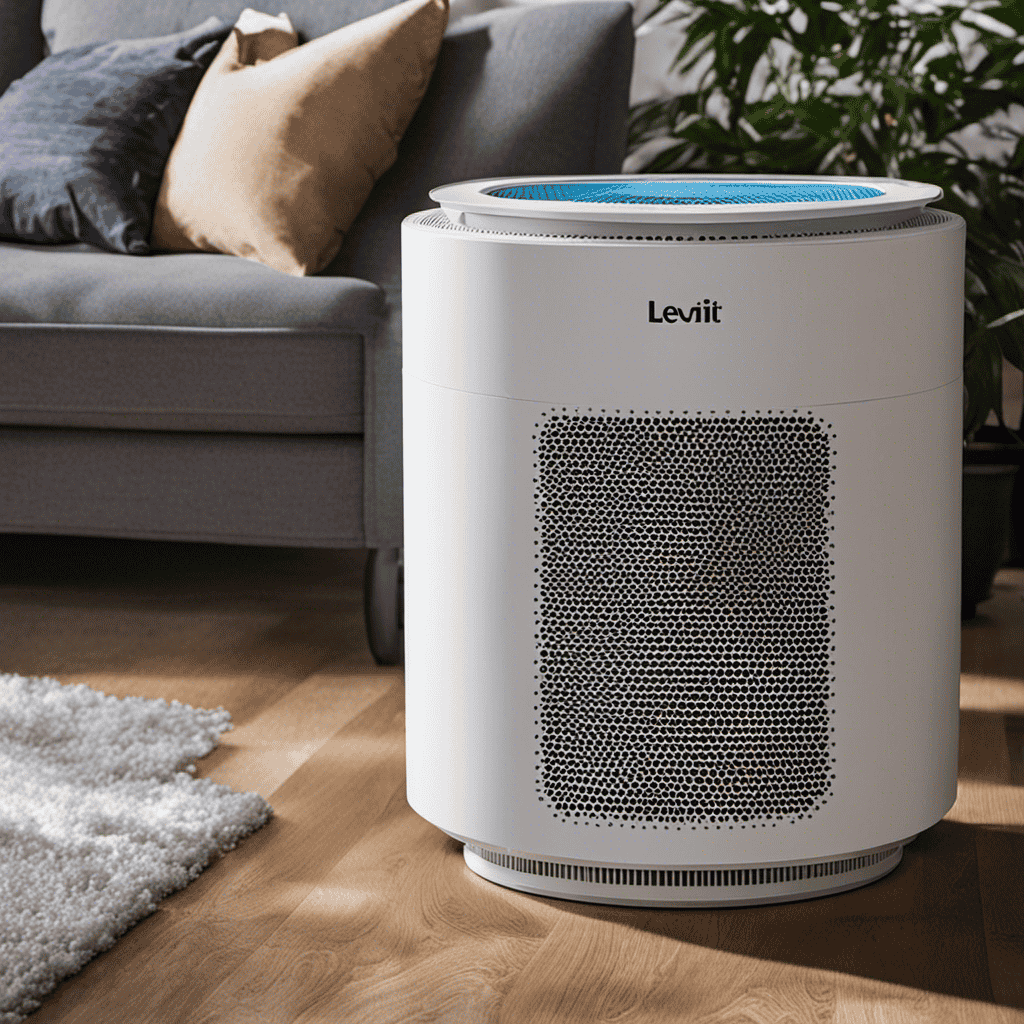Have you ever questioned whether your air purifier is truly performing effectively?
Well, I can assure you, I’ve been there. That’s why I’ve compiled a comprehensive guide on how to determine if your air purifier is working effectively.
From checking air quality to measuring dust and allergen levels, we will cover it all.
So, sit back, relax, and let’s dive into the world of air purifiers and how to ensure they are keeping your indoor air clean and fresh.
Key Takeaways
- Use an air quality monitor to assess pollutant levels and understand air quality in your home.
- Conduct a smell test and seek feedback from others to evaluate the effectiveness of the air purifier in reducing odors.
- Verify dust and allergen removal by using visual inspection, laser particle counters, and comparing particle levels with and without the air purifier.
- Ensure proper ventilation to remove pollutants, prevent moisture buildup, and maintain healthy indoor air quality.
Checking the Air Quality
If you’re wondering if your air purifier is working, you can use an air quality monitor to check the levels of pollutants in your home. Assessing air pollutants and analyzing air quality is crucial in determining the effectiveness of your air purifier.
An air quality monitor measures various pollutants such as particulate matter, volatile organic compounds (VOCs), and carbon dioxide levels in the air. These devices provide real-time data that can help you understand the air quality in your home and identify any potential issues.
Assessing the Odor Reduction
To assess whether your air purifier is reducing odors, simply take a deep breath and see if there is a noticeable improvement in the smell of the room. It’s important to have a reliable method for measuring air freshness and evaluating scent reduction.
Here are three ways you can effectively determine if your air purifier is doing its job:
-
Conduct a smell test: Before turning on the air purifier, take note of any unpleasant odors in the room. Then, run the purifier for a few hours and take another deep breath. If the air smells fresher and the odors are reduced, it’s a good sign that the purifier is working.
-
Use an air quality monitor: These devices measure various air pollutants, including volatile organic compounds (VOCs) that contribute to odors. By monitoring the levels before and after using the air purifier, you can objectively assess the reduction in odors.
-
Seek feedback from others: Ask family members or visitors if they notice any improvement in the scent of the room. Their input can provide additional confirmation of the air purifier’s effectiveness.
By evaluating the changes in air freshness and scent reduction, you can gain confidence in the performance of your air purifier.
Now let’s move on to monitoring dust and allergen levels to ensure your air is truly clean.
Monitoring Dust and Allergen Levels
When it comes to monitoring dust and allergen levels, there are several key points to consider.
Firstly, dust detection methods play a crucial role in determining the presence of airborne particles in our environment.
Secondly, allergen level indicators help us understand the severity of allergens in the air, allowing us to take appropriate measures to mitigate their impact.
Lastly, real-time air monitoring provides us with up-to-date information on the quality of our indoor air, enabling us to make informed decisions regarding air purification and overall health and wellness.
Dust Detection Methods
One way to determine if your air purifier is working properly is by using dust detection methods. These methods can help you assess the efficiency of your air purifier in removing dust particles of different sizes.
Here are three dust detection methods that you can use:
-
Visual inspection: Take a white cloth or tissue and wipe it across surfaces in your home. If you notice a significant amount of dust particles on the cloth, it indicates that your air purifier may not be efficiently capturing and removing dust.
-
Laser particle counters: These devices use lasers to count and measure the size of dust particles in the air. By comparing the particle count before and after running your air purifier, you can determine its effectiveness in reducing dust particle concentration.
-
Air quality monitors: These devices measure the levels of various pollutants in the air, including dust particles. By monitoring the changes in dust particle levels over time, you can assess the performance of your air purifier.
Allergen Level Indicators
Check the allergen level indicators on your air purifier to see if it’s effectively reducing allergens in your indoor air. These indicators are a valuable tool for monitoring the indoor air quality and checking the status of your air purifier’s filters.
The allergen level indicators provide real-time information on the presence of allergens such as pollen, dust mites, pet dander, and mold spores in your home. By regularly checking these indicators, you can ensure that your air purifier is working efficiently and effectively to remove these allergens from your indoor air.
This is especially important for individuals with allergies or respiratory conditions who rely on clean air for their well-being. Indoor air quality monitoring through allergen level indicators is an essential aspect of maintaining a healthy living environment.
Real-Time Air Monitoring
The real-time air monitoring feature on my air purifier provides valuable information on the presence of allergens in my home. It allows me to track the air pollution levels in real time, giving me peace of mind knowing that the air I breathe is clean and healthy.
Here are 3 reasons why real-time air monitoring is important for air purifier performance analysis:
-
Accurate Data: With real-time monitoring, I can get accurate and up-to-date information on the air quality in my home. This helps me understand the effectiveness of my air purifier and make necessary adjustments if needed.
-
Timely Alerts: The real-time monitoring feature also provides timely alerts when the air pollution levels exceed the desired threshold. This helps me take immediate action, such as increasing the fan speed or changing the filter, to maintain optimal air quality.
-
Long-term Analysis: By tracking the air pollution levels over time, I can analyze the performance of my air purifier and identify any patterns or trends. This allows me to make informed decisions about the maintenance and replacement of filters, ensuring that my air purifier continues to work efficiently.
Measuring the Indoor Air Pollution
To measure indoor air pollution, you can use a portable air quality monitor. These devices are designed to assess the levels of various air pollutants that may be present in your home or office. They typically measure parameters such as particulate matter, volatile organic compounds (VOCs), carbon dioxide, and humidity.
By monitoring these factors, you can get a comprehensive understanding of the indoor air quality and identify potential sources of pollution. Portable air quality monitors provide real-time data, allowing you to make informed decisions about how to improve the air quality in your environment.
Regularly assessing indoor air pollution is crucial for maintaining a healthy living or working space. It enables you to take necessary measures to reduce exposure to harmful pollutants and create a safer indoor environment for yourself and others.
Verifying the Filter’s Efficiency
In the previous section, I discussed the importance of measuring indoor air pollution. Now, let’s move on to verifying the efficiency of the air purifier’s dust filter. This is crucial because the filter is responsible for trapping harmful particles and improving the air quality in our homes.
Here are three ways to determine the effectiveness of a dust filter:
-
Particle Size Measurement: Dust particles come in various sizes, and a good air purifier should be able to capture particles as small as 0.3 microns. By measuring the particle size before and after filtration, we can assess the filter’s efficiency.
-
Air Quality Monitoring: Using an air quality monitor, we can compare the particle levels in the room with and without the air purifier operating. A significant reduction in airborne particles indicates the filter is doing its job effectively.
-
Filter Replacement Schedule: Regularly checking and replacing the filter is essential to maintain its efficiency. If the filter gets clogged quickly or does not last as long as specified, it may be a sign of poor filter performance.
Now that we understand how to verify the dust filter’s efficiency, let’s move on to testing for mold and mildew spores.
Testing for Mold and Mildew Spores
Now let’s see how we can test for mold and mildew spores in our indoor air. Mold spore detection and mildew spore measurement are crucial in ensuring a healthy indoor environment. There are several methods available for testing air samples for these spores. One common approach is using a mold test kit, which typically consists of a petri dish and a nutrient medium. The air sample is collected and placed on the medium, allowing any mold or mildew spores to grow and become visible. Another method is using an air sampling pump that draws in air and collects particles on a filter. These samples can then be analyzed under a microscope to identify and quantify mold and mildew spores.
| Testing Method | Description |
|---|---|
| Mold Test Kits | Utilizes petri dishes and nutrient mediums to grow spores |
| Air Sampling Pump | Collects air samples on a filter for microscopic analysis |
Ensuring Proper Ventilation
Make sure your home has proper ventilation to maintain good indoor air quality. Ventilation plays a crucial role in ensuring the circulation of fresh air and the removal of harmful indoor pollutants.
Here are three reasons why proper ventilation is important:
-
Remove indoor pollutants: Ventilation helps to remove indoor pollutants such as volatile organic compounds (VOCs), carbon monoxide (CO), and allergens. These pollutants can accumulate in poorly ventilated spaces and have detrimental effects on our health.
-
Control moisture levels: Proper ventilation helps to control moisture levels in your home. Excess moisture can lead to the growth of mold and mildew, which can trigger allergies and respiratory issues. By allowing fresh air to circulate, ventilation helps to prevent the buildup of moisture and maintain a healthy indoor environment.
-
Measure CO2 levels: Ventilation can also help to maintain appropriate levels of carbon dioxide (CO2) in your home. High levels of CO2 can cause drowsiness, headaches, and poor concentration. By measuring CO2 levels and ensuring proper ventilation, you can create a comfortable and healthy living environment.
Examining the Noise Levels
Excess noise levels can negatively impact the comfort and tranquility of your living space. When it comes to air purifiers, noise can be an important factor to consider. Not only can a noisy air purifier disrupt your peace, but it can also indicate potential issues with its performance and efficiency. To determine the performance and evaluate the efficiency of your air purifier, you can utilize the following table:
| Noise Level | Description |
|---|---|
| Low | Barely audible, doesn’t disturb sleep |
| Moderate | Noticeable but tolerable |
| High | Distracting, interferes with activities |
| Very High | Extremely loud, unbearable |
| Silent | No noise emitted |
Evaluating the Energy Consumption
By comparing the noise level of your air purifier to the descriptions in the table, you can assess its effectiveness in providing a quiet and peaceful environment while efficiently purifying the air in your living space.
However, evaluating an air purifier’s performance goes beyond noise levels. Another important aspect to consider is the filter efficiency. A high-quality air purifier should have a filter that can effectively capture a wide range of pollutants, such as dust, pollen, and pet dander.
Additionally, it should be able to track energy usage. Look for an air purifier that is ENERGY STAR certified, as this indicates that it meets strict energy efficiency guidelines.
Analyzing the Air Purifier’s Lifespan
To determine the lifespan of your air purifier, check the manufacturer’s recommendations for filter replacement and maintenance. Analyzing filter maintenance is crucial in evaluating the effectiveness of your air purifier. Regularly replacing and cleaning the filters is essential to ensure optimal performance and longevity of the device. The table below provides a breakdown of the recommended filter maintenance schedule for different types of air purifiers:
| Type of Air Purifier | Filter Type | Recommended Maintenance |
|---|---|---|
| HEPA Air Purifier | HEPA | Replace every 6-12 months |
| Carbon Air Purifier | Carbon | Replace every 3-6 months |
| Ionizer Air Purifier | Electrostatic | Clean every 1-3 months |
| UV-C Air Purifier | UV-C | Replace every 9-12 months |
Confirming the Airflow Rate
Confirming the airflow rate is essential to ensure that your air purifier is operating at an optimal level. Verifying air circulation and confirming air purification can help you determine if your air purifier is working as it should. Here are three ways to confirm the airflow rate:
-
Check the manufacturer’s specifications: The airflow rate is usually provided in the product manual or on the manufacturer’s website. Compare the specified airflow rate with the actual airflow rate of your air purifier to ensure they are consistent.
-
Use an anemometer: An anemometer is a device that measures air velocity. By placing it in front of the air purifier’s intake or output, you can measure the airflow rate and confirm its effectiveness.
-
Monitor air quality: A decrease in airborne pollutants, such as dust particles or allergens, indicates that the air purifier is effectively circulating and purifying the air. Regularly monitor the air quality in your living space to confirm the air purifier’s performance.
Comparing Before and After Results
When evaluating the effectiveness of an air purifier, it is important to consider several key points.
First, measuring air quality can be done using air quality monitors that measure particulate matter and other pollutants in the air.
Second, visible dust reduction can be assessed by comparing the amount of dust particles present before and after using the air purifier.
Measuring Air Quality
You can easily measure the air quality in your home by using a digital air quality monitor. These devices provide real-time data on the levels of various air pollutants present in your indoor environment.
Here are three reasons why measuring air quality is important:
-
Health: Monitoring air pollutants allows you to assess the potential health risks associated with poor air quality. By knowing the levels of pollutants such as particulate matter, volatile organic compounds, and carbon dioxide, you can take appropriate measures to protect yourself and your family.
-
Air Quality Index (AQI) correlation: Measuring air quality helps you understand the correlation between the levels of pollutants and the AQI. The AQI provides a standardized measure of air quality, ranging from good to hazardous. By monitoring the pollutants, you can easily interpret the AQI and take necessary actions.
-
Evaluation of air purifier effectiveness: Measuring air quality before and after using an air purifier allows you to evaluate its effectiveness. By comparing the pollutant levels, you can determine if the air purifier is successfully reducing the concentration of harmful substances in your home.
Overall, measuring air quality provides valuable insights for maintaining a healthy indoor environment and ensuring the effectiveness of air purification devices.
Visible Dust Reduction
To visibly reduce dust in your home, consider using a high-efficiency particulate air (HEPA) filter in your vacuum cleaner. These filters are designed to capture small particles, including dust, pollen, and pet dander, improving your indoor air quality.
But how do you know if your efforts are actually reducing the amount of dust in your home? One way to measure the effectiveness of your dust reduction methods is through dust particle detection.
There are devices available that can detect and count the number of dust particles in the air, providing you with a quantitative measurement of your air quality improvement. By regularly monitoring the dust particle levels in your home, you can ensure that your cleaning and air purifying efforts are making a noticeable difference in reducing dust and improving your overall air quality.
Odor Elimination Effectiveness
Using an air purifier with activated carbon filters can effectively eliminate odors in your home. I have personally experienced the benefits of using such a device and it has made a noticeable difference in the air quality. Here are three reasons why I believe air purifiers with activated carbon filters are so effective:
-
Absorption: The activated carbon filters in these purifiers have a large surface area that helps trap and absorb odors. This process effectively removes the odor-causing particles from the air.
-
Chemical filtration: Activated carbon filters are designed to target specific chemicals and gases that contribute to unpleasant odors. They can effectively neutralize these compounds, leaving your home smelling fresh and clean.
-
Longevity: With proper air purifier maintenance and regular filter replacement, the activated carbon filters can last for a significant amount of time. This ensures that your purifier continues to effectively eliminate odors for an extended period.
Regular air purifier maintenance and filter replacement are crucial to ensure optimal performance and odor elimination. By following these steps, you can enjoy a clean and fresh-smelling home.
Validating the Removal of Pet Dander
Check if there’s a noticeable decrease in pet dander on surfaces around your home after using the air purifier. Validating the removal of pet dander is an important step in assessing the effectiveness of an air purifier.
One way to measure pet hair reduction is by conducting a before and after test. Before using the air purifier, collect a sample of the pet hair from various surfaces in your home. Use adhesive tape or a lint roller to remove the hair and place it in a sealed container.
After using the air purifier for a period of time, repeat the process and compare the amount of pet hair collected. If there is a significant decrease in pet hair, it indicates that the air purifier is effectively removing pet dander from the air, leading to a cleaner and healthier environment.
Assessing the Reduction of Pollen
When it comes to assessing the reduction of pollen in the air, there are several key points to consider.
First, it is important to accurately measure the pollen count in both indoor and outdoor environments. This can be done using specialized equipment that captures and counts pollen particles.
Second, the effectiveness of an air purifier in reducing pollen can be evaluated by comparing the pollen count before and after using the device.
Lastly, it is crucial to examine whether the reduction in pollen leads to an improvement in allergy symptoms for individuals prone to pollen allergies. This can be determined through self-reporting or by conducting controlled studies to assess the impact of the air purifier on allergy symptom severity.
Pollen Count Measurement
The measurement of the pollen count is crucial in determining the effectiveness of your air purifier. By regularly tracking the pollen count, you can measure the efficiency of your air purifier in removing pollen particles from the air.
Here are three reasons why measuring the pollen count is important:
-
Measuring Efficiency: Keeping track of the pollen count allows you to compare it with the indoor air quality after using the air purifier. A significant reduction in the pollen count indicates that your air purifier is effectively removing pollen particles, improving the overall air quality in your home.
-
Tracking Air Changes: Monitoring the pollen count over time helps you understand the fluctuations in pollen levels. By correlating these changes with the operation of your air purifier, you can determine the optimal times to use it and ensure maximum effectiveness.
-
Quantitative Assessment: The pollen count provides a quantitative measure of the amount of pollen in the air. Regularly measuring it allows you to assess the impact of the air purifier on reducing pollen levels, giving you a clear understanding of its performance.
Allergy Symptom Improvement
To alleviate your allergy symptoms, consider monitoring the pollen count and adjusting the use of your air purifier accordingly. Allergies can cause a range of symptoms, from sneezing and itching to congestion and watery eyes. By keeping track of the pollen count in your area, you can determine when your allergies are likely to be triggered and take appropriate measures to reduce your exposure. An air purifier can help filter out allergens such as pollen, dust mites, and pet dander, providing relief from these symptoms. By adjusting the settings on your air purifier based on the pollen count, you can optimize its effectiveness in removing allergens from the air. This can greatly improve your allergy symptoms and help you manage them more effectively.
| Pollen Count Level | Air Purifier Setting | Allergy Symptom Improvement |
|---|---|---|
| Low | Low | Mild improvement |
| Moderate | Medium | Moderate improvement |
| High | High | Significant improvement |
Air Purifier Effectiveness
Make sure you’re adjusting the settings on your air purifier based on the pollen count to optimize its effectiveness in removing allergens from the air. Proper maintenance is crucial for ensuring your air purifier functions at its best and remains cost-effective.
Here are three important steps to consider:
-
Regular filter cleaning or replacement: Over time, the filters in your air purifier can become clogged with allergens, reducing its efficiency. Cleaning or replacing the filters as recommended by the manufacturer will help maintain optimal performance.
-
Cleaning the unit: Dust and dirt can accumulate on the exterior and interior components of your air purifier, hindering its ability to effectively purify the air. Regularly cleaning the unit with a soft cloth and mild detergent will help keep it running smoothly.
-
Monitoring energy consumption: Some air purifiers can be energy-intensive, leading to higher electricity bills. Consider choosing an energy-efficient model or adjusting the settings to balance performance and cost effectiveness.
By following these maintenance practices, you can ensure that your air purifier continues to effectively remove allergens from the air and provide a clean and healthy environment.
Now, let’s delve into verifying the elimination of harmful gases.
Verifying the Elimination of Harmful Gases
You can tell if your air purifier is working by checking if it’s effectively removing harmful gases. One way to verify chemical removal is by testing for VOC reduction.
VOCs, or volatile organic compounds, are chemicals that can be found in many household products and can be harmful to human health. To test for VOC reduction, you can use a VOC meter or an air quality monitor that measures the levels of these compounds in the air.
Before using the air purifier, measure the initial VOC levels in the room. Then, run the air purifier for a designated period of time and measure the VOC levels again. If the levels have significantly decreased, it indicates that the air purifier is effectively removing harmful gases and chemicals from the air.
Frequently Asked Questions
How Often Should I Replace the Air Purifier Filter?
I replace my air purifier filter every 6 months or as recommended by the manufacturer. Signs that my filter needs replacement include reduced airflow, unpleasant odors, and a decrease in the air purifier’s effectiveness.
Can an Air Purifier Completely Eliminate All Indoor Allergens?
An air purifier can’t eliminate all indoor allergens, but it can significantly improve indoor air quality. It’s like a filter that captures and removes a large portion of allergens, but not every single one.
Is It Necessary to Run the Air Purifier 24/7 for It to Be Effective?
It’s important to consider the effectiveness of running an air purifier without using it 24/7. While continuous usage may yield better results, periodic use can still improve indoor air quality.
Can an Air Purifier Remove Cigarette Smoke and Its Odor?
Yes, an air purifier can effectively remove cigarette smoke and its odor. Regular air purifier maintenance ensures optimal performance. The benefits of using an air purifier include cleaner air, reduced allergens, and improved indoor air quality.
How Do I Know if My Air Purifier Is Removing Harmful Gases Like Vocs?
I can determine if my air purifier is removing harmful gases like VOCs by regularly checking the air quality indicators, monitoring any changes in odors or symptoms, and conducting air quality tests. Proper air purifier maintenance ensures optimal performance and the benefits of using an air purifier.
Can I Determine if I Need an Air Purifier Based on Its Effectiveness in a Room?
When considering an air purifier’s effectiveness in a room, air purifier necessity cues can help determine if one is needed. These cues include noticeable dust buildup, persistent odors, and allergy symptoms. If these issues are present, an air purifier may be beneficial for improving indoor air quality.
Conclusion
In conclusion, determining the effectiveness of your air purifier requires a comprehensive evaluation. By checking the air quality, assessing odor reduction, monitoring dust and allergen levels, and measuring indoor air pollution, you can ensure a thorough analysis.
Additionally, verifying filter efficiency, comparing before and after results, validating removal of pet dander, assessing reduction of pollen, and verifying elimination of harmful gases are all important steps in evaluating your air purifier’s performance.
So, don’t leave your air purifier’s performance to chance – take these steps to know if it’s truly working to create a healthier indoor environment.










